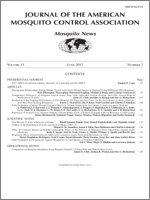We conducted a study to compare the effectiveness of the Biogents Gravid Aedes Trap (BG-GAT) and Centers for Disease Control and Prevention (CDC) Autocidal Gravid Ovitrap (AGO) with that of the CDC Gravid Trap (CDC-GT) (as a standard) for their proficiency to collect mosquitoes in an urban residential neighborhood in northeastern Florida. Aedes aegypti, Ae. albopictus, and Culex quinquefasciatus were collected from each trap, with the latter species being predominant. Significantly more Cx. quinquefasciatus were collected from CDC-GT traps compared with the other 2 traps. Pairwise comparison of the efficiency of the CDC-GT revealed that this trap collected 6.7- to 21.5-fold more mosquitoes than the BG-GAT, depending on species. The BG-GAT collected overall more mosquitoes (3- to 6-fold) than the AGO, with the exception of Ae. aegypti, where both traps were nearly equal in effectiveness.
How to translate text using browser tools
1 June 2017
Comparative Efficiency of Biogents Gravid Aedes Trap, Cdc Autocidal Gravid Ovitrap, and CDC Gravid Trap in Northeastern Florida
James E. Cilek,
Jennifer A. Knapp,
Alec G. Richardson
ACCESS THE FULL ARTICLE
It is not available for individual sale.
This article is only available to subscribers.
It is not available for individual sale.
It is not available for individual sale.
Aedes aegypti
Aedes albopictus
autocidal gravid ovitrap
Culex quinquefasciatus
gravid Aedes trap





